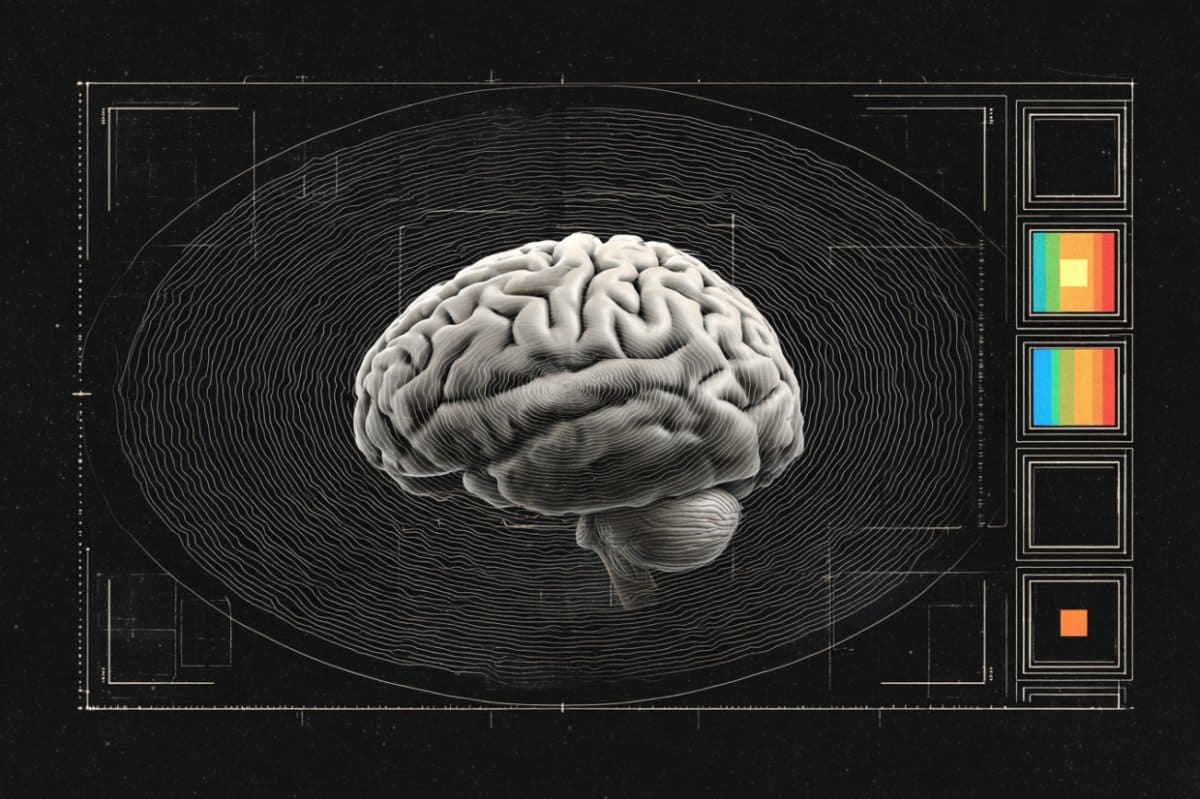Summary: New research shows that the brain’s ability to detect subtle visual changes—like spotting an anomaly on a security monitor—depends on theta-frequency brain waves (3–6 Hz) that rhythmically sweep across the cortex. These traveling waves act like a radar, scanning different parts of the visual field and influencing when and where attention peaks.
The study reveals that reaction time and accuracy depend on the phase of this theta wave at the moment a change occurs, linking rhythmic brain activity to moment-to-moment visual performance. The findings not only deepen understanding of working memory but also suggest new ways to enhance attention in neurological conditions where theta activity is weak.
Key Facts:
- Theta Scanning: A 3–6 Hz theta wave moves across the visual cortex like a radar, influencing when visual detection is strongest.
- Performance Link: Reaction times and accuracy vary depending on the theta wave phase and where a target appears in the visual field.
- Clinical Potential: Strengthening theta rhythms could help improve attention and visual working memory in brain disorders.
Source: Picower Institute at MIT
Imagine you are a security guard in one of those casino heist movies where your ability to recognize an emerging crime will depend on whether you notice a subtle change on one of the many security monitors arrayed on your desk. That’s a challenge of visual working memory.
According to a new study by neuroscientists in The Picower Institute for Learning and Memory at MIT, your ability to quickly spot the anomaly could depend on a theta-frequency brain wave (3–6 Hz) that scans through a region of the cortex that maps your field of view.
The findings in animals, published Oct. 20 in Neuron, help to explain how the brain implements visual working memory and why performance is both limited and variable. Prior studies by other labs have found that attention also rises and falls with theta waves.
And numerous studies by the lab of Picower Professor Earl K. Miller have supported the theory that the brain employs waves of different frequencies to carry out the analog computations needed for cognitive tasks such as working memory.
The new study provides a new illustration of the effects of those brain waves on function.
“It shows that waves impact performance as they sweep across the surface of the cortex. This raises the possibility that traveling waves are organizing or even performing neural computation,” said Miller, also a faculty member in MIT’s Department of Brain and Cognitive Sciences.
Hio-Been Han, a former postdoc in Miller’s lab and now an Assistant Professor at Seoul National University, led the study.
A radar-like wave
In the study, animals played a video game in which an array of colored squares appeared and then disappeared on a screen. After about a second, the array reappeared with one square sporting a different color. The animals had to glance at the one that changed, ideally as quickly as possible. To keep score, the researchers tracked the reaction time and position of the animals’ gaze.
They also measured brain wave power across a broad frequency spectrum and individual neural electrical “spikes” in a region called the “frontal eye fields” that maps visual information analogously to where it first hits the retina (a so-called “retinotopic” map).
In their post-hoc analysis of hundreds of trials of the game, the researchers noticed that the animals’ accuracy and speed turned out to depend on a combination of the phase of a theta frequency brainwave when the changed square appeared, and the vertical location on the screen of that target square.
In other words, each height on the screen had its own phase of the theta wave where performance was at its best, and the lower a target square appeared on the screen, the later the phase of the wave that correlated with peak performance.
“The optimal theta phase for behavior varied by retinotopic target location, progressing from the top to the bottom of the visual field,” the researchers wrote in Neuron. “This could be explained by a traveling wave of activity across the cortical surface during the memory delay.”
The finding suggests that the brain’s system for spotting changes in its visual field has some degree of rhythmic variability. If the wave phase at the time the changed square appeared was optimal for where the square was, performance was better. If it wasn’t, performance was worse.
Miller said his lab will need to continue studying the phenomenon to understand why it might have evolved the way it did. Theta is a commonly observed mechanism of attention when animals have to monitor more than one location at a time, Miller noted.
Further findings
Other findings in the study add to the evidence base Miller’s lab has been building for how the brain uses waves in its operations and computations. Numerous studies by his lab, for instance, have shown that alpha and beta frequency waves (~8-25 Hz) impose the brain’s understanding of the rules of a task and regulate when faster gamma frequency waves (30Hz and above), can be used to encode data from the senses.
Sure enough, in this study, the lab observed that theta waves seemed to orchestrate that rivalry between beta and gamma. In the excitatory phase of the theta waves, beta was suppressed and visual information was evident in the neural spiking activity. In the inhibitory phase of theta, beta power was stronger and the spiking decreased.
The study also showed that the effect of the theta wave on performance increased depending on how many squares the animals had to remember. That raises a potential clinical implication, Miller said.
His lab is working to develop closed-loop analog feedback systems that can strengthen the power of waves at different frequencies. In disorders where theta power is too low, the study suggests that visual working memory capacity could suffer, but that intervention could help.
In addition to Han and Miller, the study’s other authors are Scott Brincat, a research scientist in Miller’s lab, and Timothy Buschman, a professor at Princeton University.
Funding: The Office of Naval Research, the National Eye Institute of the NIH, The National Research Foundation of Korea, Seoul National University, the Freedom Together Foundation and The Picower Institute for Learning and Memory funded the research.
Key Questions Answered:
A: Theta-frequency brain waves travel across the cortex like a radar, determining how quickly and accurately the brain spots visual changes.
A: The waves rhythmically gate attention and neural activity, meaning performance fluctuates depending on when and where the visual signal aligns with the theta phase.
A: Because weakened theta activity can limit attention and memory capacity, therapies that strengthen these waves could enhance cognitive function.
About this visual neuroscience and memory research news
Author: David Orenstein
Source: Picower Institute at MIT
Contact: David Orenstein – Picower Institute at MIT
Image: The image is credited to Neuroscience News
Original Research: Open access.
“Working memory readout varies with frontal theta rhythms” by Earl K. Miller et al. Neuron
Abstract
Working memory readout varies with frontal theta rhythms
Increasing evidence suggests that attention varies rhythmically, phase locked to ongoing cortical oscillations.
Here, we report that the phase of theta oscillations (3–6 Hz) in the frontal eye field (FEF) is associated with the spatiotemporal variation of information readout from working memory (WM).
Non-human primates were briefly shown a sample array of colored squares. A short time later, they viewed a test array and were rewarded for identifying which square changed color (the target).
Behavioral performance varied systematically with theta phase at the time of test array onset, as well as with the target’s location. This is consistent with theta “scanning” across the FEF and thus visual space from top to bottom.
Theta was coupled, on opposing phases, to both spiking and beta (12–20 Hz). These results could be explained by a wave of activity that moves across the FEF, modulating the readout of information from WM.







